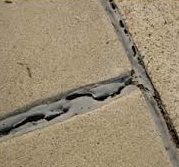Sealant Is Not A Water Proofing Solution
 Watch enough TV and you will see adverts for sealant (or Caulk) which will solve all your leaks and waterproofing problems.
Watch enough TV and you will see adverts for sealant (or Caulk) which will solve all your leaks and waterproofing problems.
In my experience sealant is really an extra step in good design.
You should be looking to make sure that water is directed away from building joints, to keep them as dry as possible.
The sealant is really just an additional step to make extra sure.
If you are just relying on the sealant here are some of the ways things can go wrong,
Some of the causes of sealant failure
1. Aging Most sealants deteriorate as they get older and can become dry, brittle, cracked crazed.
2. Incorrect Sealant Sealant are deigned for particular applications. . . . just because you have some sealant left over from a job doesn’t mean its going to be successful in a different application.
3. Inadequate Surface Preparation Dirt, dust, debris, other contaminant s and/or omission of any required sealant primer can result in early failure.
4. Incompatibility If sealant and substrate incompatible causing an adverse reaction at the sealant/substrate interface.
5. Excessive Joint Movement Actual joint movement exceedes the movement capabilities of the joint sealant causing tearing.
6. Early Joint Movement before Sealant Cure Early joint movement due to large temperature during during the initial sealant cure cycle cause surface wrinkling and cracking.
7 Improper Sealant Application Several reasons including:
- Improper sealant dimensions (width to depth ratio.
- Sealant was not properly mixed leading to insufficient cure and poor sealant performance (applicable to multi-component sealants only).
- Three-sided adhesion due to inappropriate or non-existent sealant backing.
- Inadequate sealant tooling causing lack of contact at sealant / substrate interface.